JUDO Golev Ruslan Judo is amodernmartial art,
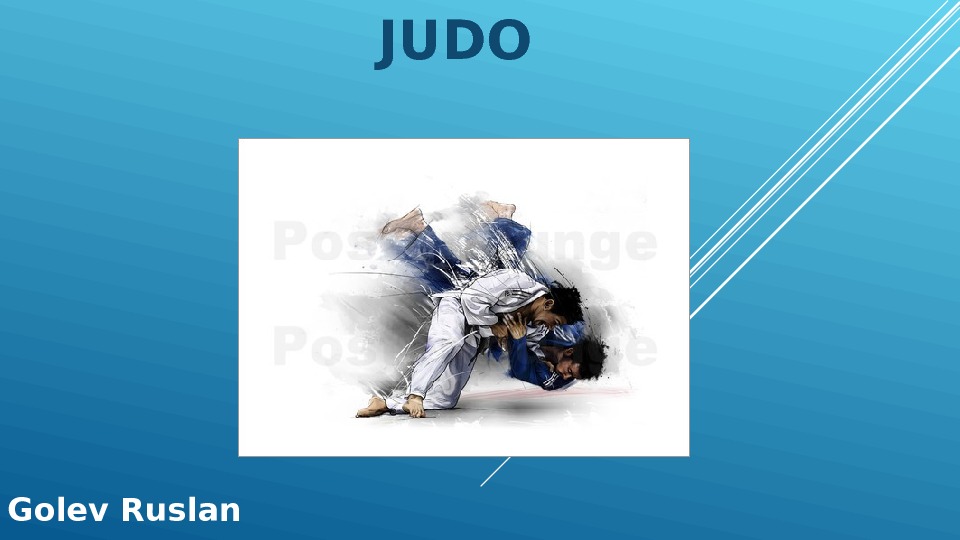
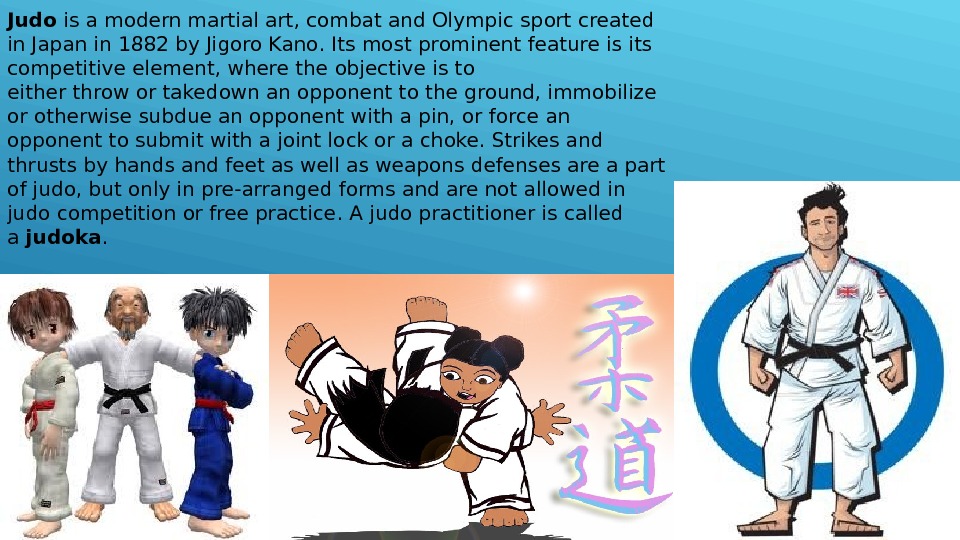
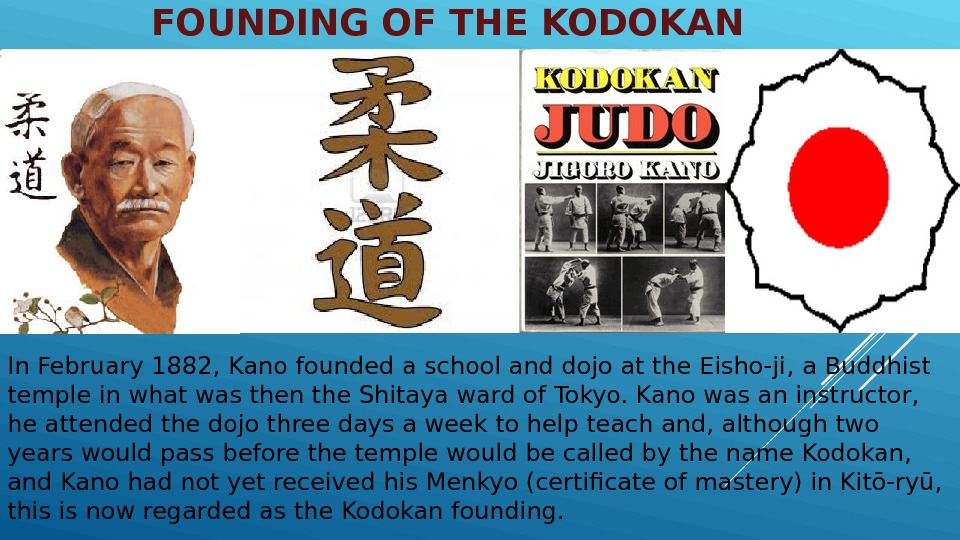
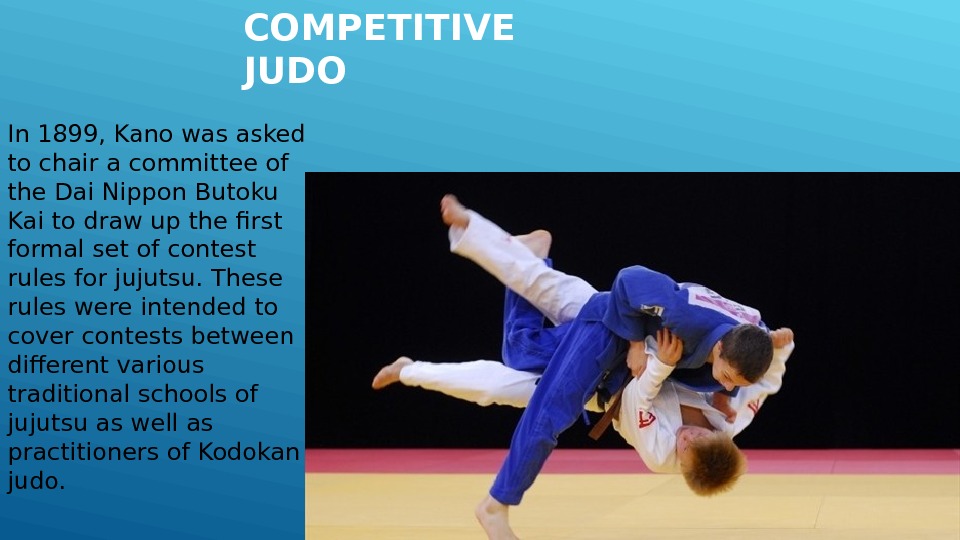
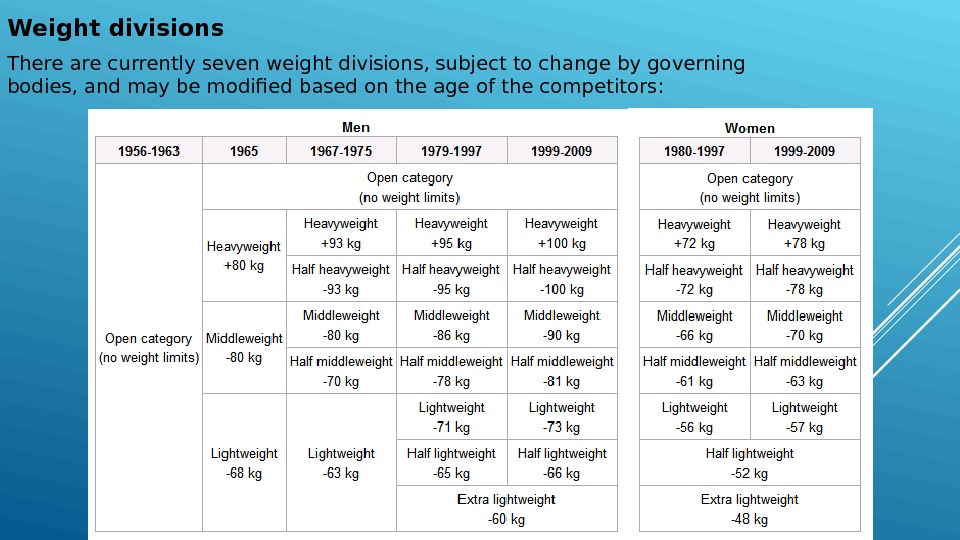
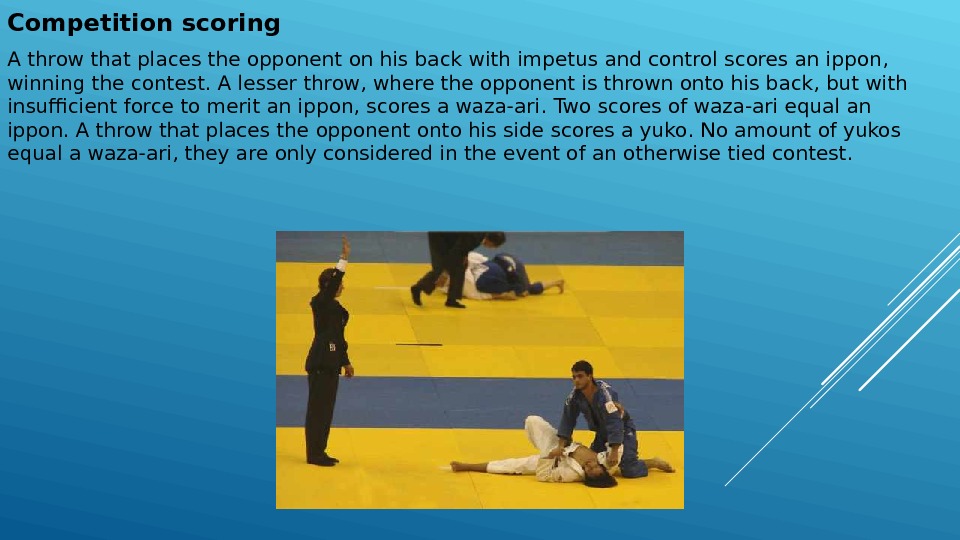
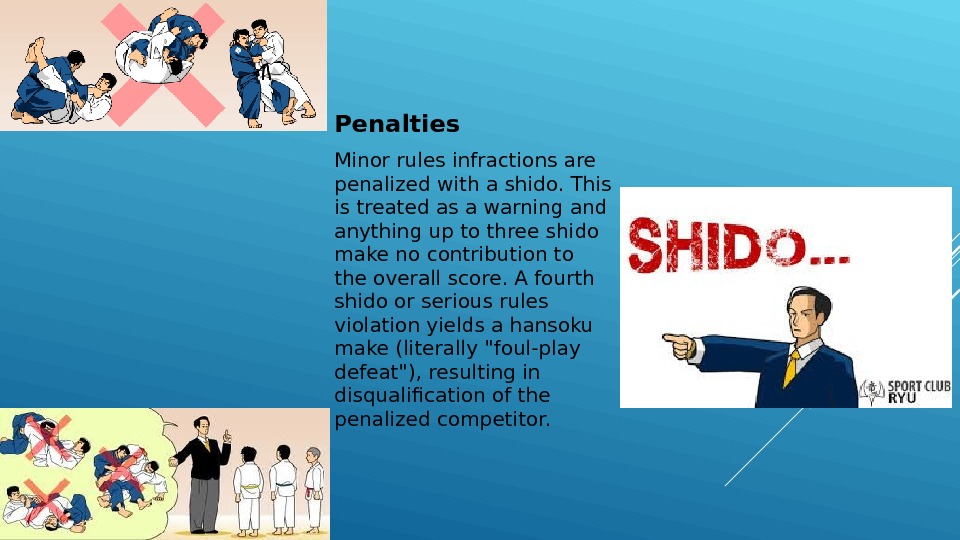
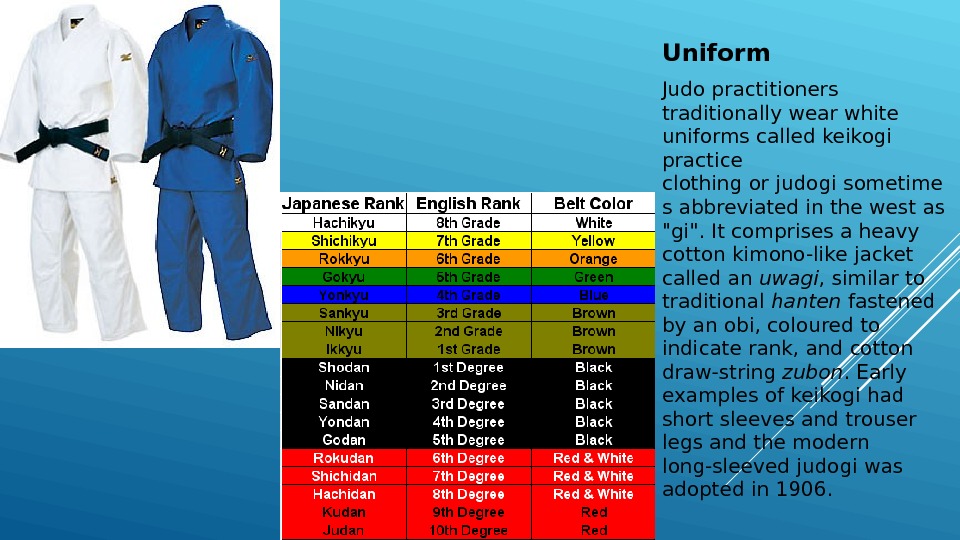
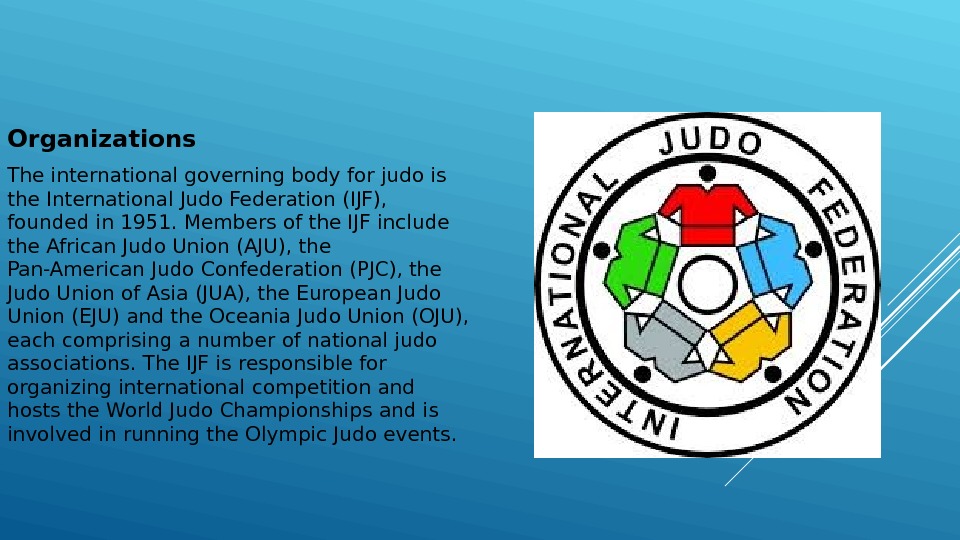

- Размер: 1.8 Mегабайта
- Количество слайдов: 10
Описание презентации JUDO Golev Ruslan Judo is amodernmartial art, по слайдам
 JUDO Golev Ruslan
JUDO Golev Ruslan
 Judo is amodernmartial art, combatand. Olympicsport created in. Japanin 1882 by. Jigoro Kano. Its most prominent feature is its competitive element, where the objective is to eitherthrowortakedownan opponent to the ground, immobilize or otherwise subdue an opponent with apin, or force an opponent to submit with ajoint lockor achoke. Strikesand thrusts by hands and feet as well as weapons defenses are a part of judo, but only in pre-arranged forms and are not allowed in judo competition or free practice. A judo practitioner is called a judoka.
Judo is amodernmartial art, combatand. Olympicsport created in. Japanin 1882 by. Jigoro Kano. Its most prominent feature is its competitive element, where the objective is to eitherthrowortakedownan opponent to the ground, immobilize or otherwise subdue an opponent with apin, or force an opponent to submit with ajoint lockor achoke. Strikesand thrusts by hands and feet as well as weapons defenses are a part of judo, but only in pre-arranged forms and are not allowed in judo competition or free practice. A judo practitioner is called a judoka.
 FOUNDING OF THE KODOKAN In February 1882, Kano founded a school and dojo at the Eisho-ji , a Buddhist temple in what was then the Shitaya ward of Tokyo. Kano was an instructor, he attended the dojo three days a week to help teach and, although two years would pass before the temple would be called by the name Kodokan, and Kano had not yet received his Menkyo (certificate of mastery) in Kitō-ryū, this is now regarded as the Kodokan founding.
FOUNDING OF THE KODOKAN In February 1882, Kano founded a school and dojo at the Eisho-ji , a Buddhist temple in what was then the Shitaya ward of Tokyo. Kano was an instructor, he attended the dojo three days a week to help teach and, although two years would pass before the temple would be called by the name Kodokan, and Kano had not yet received his Menkyo (certificate of mastery) in Kitō-ryū, this is now regarded as the Kodokan founding.
 COMPETITIVE JUDO In 1899, Kano was asked to chair a committee of the. Dai Nippon Butoku Kaito draw up the first formal set of contest rules for jujutsu. These rules were intended to cover contests between different various traditional schools of jujutsu as well as practitioners of Kodokan judo.
COMPETITIVE JUDO In 1899, Kano was asked to chair a committee of the. Dai Nippon Butoku Kaito draw up the first formal set of contest rules for jujutsu. These rules were intended to cover contests between different various traditional schools of jujutsu as well as practitioners of Kodokan judo.
 Weight divisions There are currently seven weight divisions, subject to change by governing bodies, and may be modified based on the age of the competitors:
Weight divisions There are currently seven weight divisions, subject to change by governing bodies, and may be modified based on the age of the competitors:
 Competition scoring A throw that places the opponent on his back with impetus and control scores an ippon , winning the contest. A lesser throw, where the opponent is thrown onto his back, but with insufficient force to merit an ippon, scores a waza-ari. Two scores of waza-ari equal an ippon. A throw that places the opponent onto his side scores a yuko. No amount of yukos equal a waza-ari, they are only considered in the event of an otherwise tied contest.
Competition scoring A throw that places the opponent on his back with impetus and control scores an ippon , winning the contest. A lesser throw, where the opponent is thrown onto his back, but with insufficient force to merit an ippon, scores a waza-ari. Two scores of waza-ari equal an ippon. A throw that places the opponent onto his side scores a yuko. No amount of yukos equal a waza-ari, they are only considered in the event of an otherwise tied contest.
 Penalties Minor rules infractions are penalized with a shido. This is treated as a warning and anything up to three shido make no contribution to the overall score. A fourth shido or serious rules violation yields a hansoku make(literally «foul-play defeat»), resulting in disqualification of the penalized competitor.
Penalties Minor rules infractions are penalized with a shido. This is treated as a warning and anything up to three shido make no contribution to the overall score. A fourth shido or serious rules violation yields a hansoku make(literally «foul-play defeat»), resulting in disqualification of the penalized competitor.
 Uniform Judo practitioners traditionally wear white uniforms calledkeikogi practice clothingorjudogisometime s abbreviated in the west as «gi». It comprises a heavy cotton kimono-like jacket called an uwagi , similar to traditional hanten fastened by anobi, coloured to indicaterank, and cotton draw-string zubon. Early examples of keikogi had short sleeves and trouser legs and the modern long-sleeved judogi was adopted in 1906.
Uniform Judo practitioners traditionally wear white uniforms calledkeikogi practice clothingorjudogisometime s abbreviated in the west as «gi». It comprises a heavy cotton kimono-like jacket called an uwagi , similar to traditional hanten fastened by anobi, coloured to indicaterank, and cotton draw-string zubon. Early examples of keikogi had short sleeves and trouser legs and the modern long-sleeved judogi was adopted in 1906.
 Organizations The international governing body for judo is the. International Judo Federation(IJF), founded in 1951. Members of the IJF include the African Judo Union (AJU), the Pan-American Judo Confederation (PJC), the Judo Union of Asia (JUA), the European Judo Union (EJU) and the Oceania Judo Union (OJU), each comprising a number of national judo associations. The IJF is responsible for organizing international competition and hosts the World Judo Championships and is involved in running the Olympic Judo events.
Organizations The international governing body for judo is the. International Judo Federation(IJF), founded in 1951. Members of the IJF include the African Judo Union (AJU), the Pan-American Judo Confederation (PJC), the Judo Union of Asia (JUA), the European Judo Union (EJU) and the Oceania Judo Union (OJU), each comprising a number of national judo associations. The IJF is responsible for organizing international competition and hosts the World Judo Championships and is involved in running the Olympic Judo events.
 THANK YOU FOR ATTENTION!!!
THANK YOU FOR ATTENTION!!!
